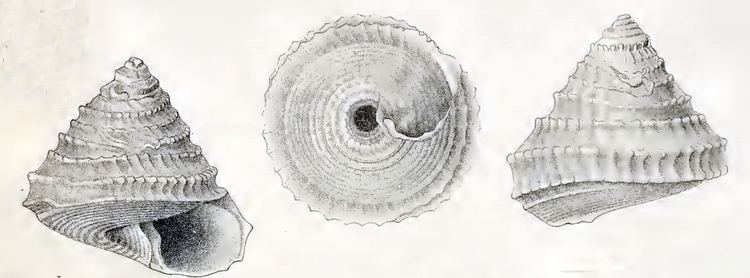Rank Species | ||
 | ||
Carenzia melvilli is a species of extremely small deep water sea snail, a marine gastropod mollusk in the family Seguenziidae.
Contents
Description
(Original description by M. Schepman) The conical, scalar, umbilicate, whitish shell is moderately large for the genus with a height of 4.5 mm, It contains seven whorls. The nucleus is wanting. The upper whorls are eroded, the lower ones each contain three spiral lirae, of which the upper one runs at a little distance from the shallow but distinct suture, which is slightly undulate. From the first liration to the second, the shell is slightly convex, this latter liration is strong, prominent and divides the whorls in two subequal parts. Below this liration the shell is concave towards the basal or peripheral liration, which in the upper whorls, runs just in the suture and in the last one borders the basal surface. These lirations are slightly spinous. Distinct undulating plications run from one to the other of the lower lirae, with the convex side towards the aperture On the upper part they are directed in an opposite way, being less distinct about halfway the interspace between the upper and median liration. Moreover, the whole shell is covered with much weaker striae, having the character of growth striae and traces of more remote spiral striae. The basal face of the shell is subconvex, but quite flat in the centre, with a shallow groove between the peripheral keel and the first of the basal lirae, this space is rather smooth, though crossed by plicae running from the peripheral spipes in an oblique direction. The outermost of the basal lirae, which is not broad, is followed by two similar ones, about as strong as their interstices, the central ones, five in number, increasing in breadth towards the centre, (one of them nearly double) being larger than the interstices These lirae are connected by small radiating riblets in the interstices. The umbilicus is bordered by a liration, consisting of a row of subquadrate beads This umbilicus is pervious and funnel-shaped. Its wall is radiately striated and has one faint spiral rib. The aperture is rounded-subquadrate. Its right margin is incomplete, its columellar margin is curved, with a denticle in the basal part. It is slightly reflected over the umbilicus. The interior of the shell is nacreous, (the nacreous texture of the inner layers is clearly visible on some of the exterior parts, where the outer layer has been removed by accidents during the youth of the animal).
This species has by its conical shape some resemblance with Carenzia trispinosa (Watson, 1879), but that species is considerably smaller, with less distinct spines, which have more the character of rounded tubercles. It has smooth interstices, without the conspicuous plications of the new species. The circumstance that the base of the specimens of trispinosa which I could compare is much smoother, seems to give no reliable distinguishing character, at least Watson ("Challenger"-Gastropoda, p. iio) says: "has some faint spirals".
I have named the new species in honour of Mr. J.C. Melvill, who has kindly sent me for comparison all his materials of this genus.
As to the radula of this species, it is a very small and rather obscure object, and only by teasing it to pieces, I could get an idea of the shape of the teeth. The uncini quite cover the median rows, and cross even the uncini of the opposite side. The rhachidian or median tooth has a subquadrate basal part, with rounded, convex posterior and less convex lateral margins. It has a broad, triangular cusp, with one small median denticle and about 6 smaller ones on each side. The laterals one on each side, have a transversely triangular shape, with an unarmed, arched upper and concave proximal and basal margin, with blunt points at the proximal and distal extremities of the basal margin. On each side I see at least 3, but I suppose there are 4 uncini which are long, slender and strongly curved. Though this radula has some resemblance with that of Aporrhais, like Verrill (Mollusca of the New England coast. Transact. Connecticut Acad, of arts and sciences, Vol. VI, May 1884, p. 1S6 and 188) has stated, and like his figure (I.e. pi. 31, fig. 14b) affirms, I cannot agree without doubt with his view that it should be taenioglossate, as the "Siboga"-specimen has a radula with at least 9 rows of teeth and probably 11. The nacreous character of the shell agrees with the Rhipidoglossa, and so does the larger number of uncini. I should think the genus will belong to the Rhipidoglossa with a restricted number of teeth, such as Basilissa. As however only a knowledge of other anatomical particulars, the position and structure of the gills, of the heart etc. can decide the question I have left the family near Trichotropis in accordance with the newest systematic arrangement of Paul Pelseneer (A treatise on Zoology, edited by Ray Lankester, Part V, Mollusca, 1906, p. 156)
Distribution
This marine species occurs off Indonesia.
